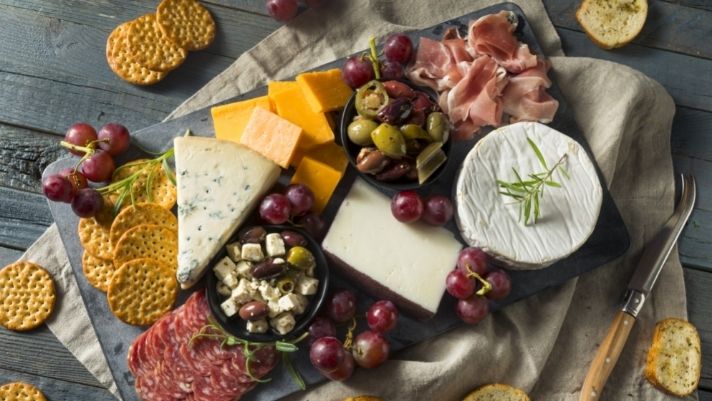Want to step up your appetizer game this summer? Charcuterie boards are your best friend—and we’ll tell you about their origins, here. Take a look!
Charcuterie—you’ve heard it a lot these past few years. You see it on more menus, your friends have a board that’s specifically for it, and you see different types these days. But what even is charcuterie? And what makes it so stellar with wine? Below, we’ll delve into the origin of the charcuterie board, some of the new favorites, and what makes wine their partner in crime. Take a look!
Let’s Visit the Past
Where Charcuterie Comes From
Before we delve into the popular boards of the day, let’s first understand where the word “charcuterie” comes from. The word is actually derived from the French (surprise!) and the words chair/flesh and cuit/cooked. Way back in the day, the word described French shops that sold products made from pork.
Although there was a heavy pork influence for the word itself, the practice of eating salted and smoked meats and cheeses dates back even further. Let’s head to Ancient Rome!
Ancient Rome’s Play
Some of the techniques the French utilized date as far back as the Roman Empire. In that time, people salted and smoked meats as a way to preserve them—they never wanted to waste food.
As we said, pork isn’t the only thing you’ll find on a charcuterie board—even in the past, you may have seen spiced sausage, cured salami, pâté, and more. Now, let’s see what’s happened to charcuterie since then.
Back To Present Day
As we said, charcuterie is taking over the world. It’s expanded quite effortlessly since the Romans and the French. Today, it includes more than just popular cured meats—there’s a variety of cheeses, veggies, fruits, breads, and jams. It’s expansive, and it’s delicious. Here are some of the popular boards of the time!
Popular Types
Cheese and Fruit
A simple board for those who don’t want the meat. It’s basically what we love to eat anyway, but put on a dish to make it fancy. Add cheeses and fruits and that’s it! Perfect for summer!
Meat and Cheese
The typical charcuterie board. Add salamis, prosciutto, other dried meats, and whatever else sparks your attention. Add your favorite cheeses, and you’ll find perfection.
Cheese, Veg, & Bread
Another meatless board that kicks it up a notch! Add tomatoes, cucumbers, olives, pickles, and whatever other veggies you’re loving. Select your favorite cheeses, add some hard and soft breads and maybe even some nuts, and enjoy!
Everything Board
Really, a charcuterie board is whatever you want it to be. But if you really want to impress your guests, put everything on there and make it pretty!
- Assortment of meats
- Variety of cheeses
- Easy veggies
- Fruits (think berries, apples, and grapes)
- Jams
- Bread, crackers, and nuts
Tips for Wine & Charcuterie Pairing
So, why are we telling you about the origin of the charcuterie board? Because it is the perfect partner for wine! You get to accentuate a multitude of flavors within the wine and the board items themselves. You really can’t go wrong with any bottle you choose, especially if it’s affordable wine online from Wines ‘Til Sold Out! Here are some of our favorite charcuterie pairings!
- Pinot Noir | Dewitt Family Pinot Noir Russian River Valley 2020
- Rosé | Le Sieur d’Eguilles Coteaux d’Aix en Provence Rosé 2022
- Sparkling | 97 Pt. Champagne Premier Cru Blanc de Noirs Brut NV André Chemin Tradition
- Pinot Grigio | Milani 1985 Pinot Grigio Delle Venezie DOC 2022
- And so much more!
Shop with us at WTSO.com and grab the bottles to go with your charcuterie now!




Charcuterie comes from the French words chair/char meaning flesh and cuite meaning cooked. That meant the board was cooked flesh and was a way for a chef to show off their skills at curing and cooking meat.
I get that people have been trained to not like meat. It has been blamed for a world of health problems that are actually caused by sugar.
But why are you applying the word charcuterie to meatless boards? You know what we used to call a plate with cheese and bread/crackers? A cheese plate.
A board that contained meat, cheese, fruit, jams, bread, crackers and nuts was called a smorgasboard.
Why does that matter? For those of us who are low carb or Keto for health reasons, hearing that there will be a charcuterie plate at the party is a welcome relief. But getting there and finding a platter that is mostly fruit, pastries, crackers, and even candy with very little meat and cheese means no food at the party for us unless we have arranged with the host to bring things we know that we can have or simply eating before the party and ignoring the food that is there.
It’s hard enough having to read every ingredient on every label when we shop to be sure there isn’t sugar in the pickles or other foods where you would not expect it to be but now, with the “expansion” of the term charcuterie, it means we have to play food detective even at gatherings with friends and family.
You are 200% spot on
What’s the difference between a charcuterie board and a deli tray?
Hi Chris! There’s no big difference between a charcuterie board and a deli tray – both are meat and cheese platters that include sweet & savory ingredients that complement the proteins.